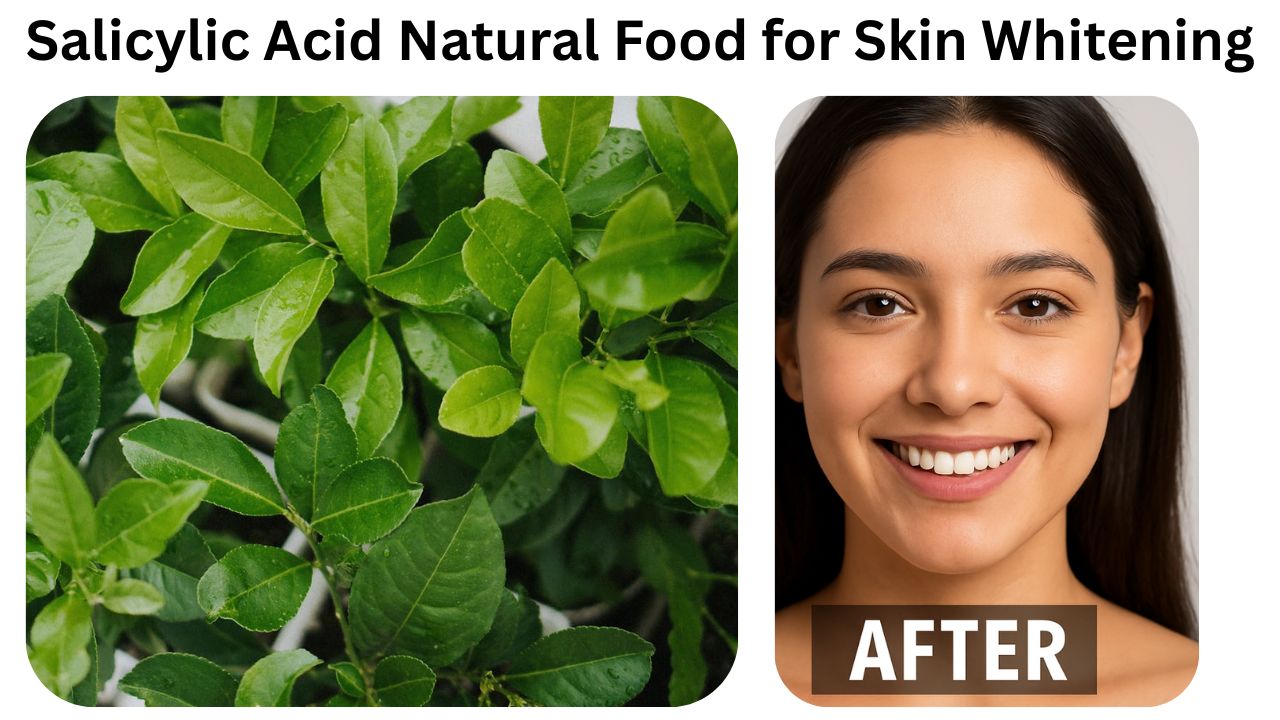When it comes to clear, bright, even skin, salicylic acid has become one of the most buzzed-about ingredients in skin care. This ingredient works in a few ways (it’s an acne-fighter and exfoliator itself ) and can be found in many creams, cleansers, and serums. But many of us ask: Salicylic Acid Natural Source for Skin Whitening
The answer is yes. Alternative Sources for Salicylic Acid When It Comes To Skin-Lightening Properties There are various Salicylic Acid Natural Source for Skin Whitening including fruits, vegetables, and herbs that can be applied to get fairer skin and reduce pigmentation- without always needing to reach for their synthetic counterparts.
In this comprehensive guide, we’ll cover:
Table of Contents
What is Salicylic Acid?
Salicylic acid is a beta hydroxy acid that comes from the willow tree. Now it is manufactured synthetically; its ancient namesakes would have had no idea that it would end up being used also as part of cosmetics and for medical purposes.
Key Features of Salicylic Acid
Is an oil on one side so actually melts and goes into the pores
It dissolves all those dead skin cells and keratin plugs (what acne and blackheads are made of.
Has antimicrobial and anti-inflammatory properties
Improves texture, tone and luminosity of the skin
Scientific Basis: How Salicylic Acid Works on Skin
Exfoliation and Skin Renewal
Keratolytic — for example, salicylic acid (which “eats” away at the top layer of the skin). It can exfoliate dead cells that can prevent skin from appearing naturally radiant and ruddy.
PubMed Study: Indicate BHI exfoliates skin and diminishes skin pigmentation.
Acne Treatment and Pigmentation Reduction
Salicylic acid exfoliates from deep inside the skin pore, targeting the oil that clogs the pores and breaks down the oil while also not even producing acne. It also fades post-inflammatory hyperpigmentation (PIH) if used regularly.
Journal of Clinical Aesthetic Dermatology: A nearly 2% confirmation salicylic acid is effective for breakouts and uneven skin tone.
Anti-inflammatory Properties
It’s anti-inflammatory so it will aid in redness, puffiness and swelling, which means it aids in skin tone.
Oil Control for Brightness
Also prevents new pimples from forming and prevents new dark spots from appearing, and skin looks bright.
Salicylic Acid Natural Source for Skin Whitening
People want natural remedies for when we are trying to look for safe and effective ways of brightening skin, most never skip salicylic acid natural source for skin whitening. Natural-based tinctures Creams and mild peels using natural sources like strawberries, tomatoes, neem, cucumber and willow bark are more skin-friendly as opposed to artificial varieties. They would slowly peel away the dead skin, lighten pigmentation and assist in attaining an evenly ‘smooth’ skin tone, without that ugly ‘burnt’ gradation.
By using these natural ingredients you can blash d acne, scars and dull skin all at once. In India however they are widely available and have been used as part of the traditional skincare regimes since centuries!
Natural Sources of Salicylic Acid
So if you’re looking for the salicylic acid natural source to lighten your skin then here’s how to go about it.
Willow Bark (Salix spp.)
Includes salicin, which becomes salicylic acid.
In Ayurveda and Western herbal medicine.
Provides anti-inflammatory and exfoliating effects.
Strawberries

Naturally abundant in salicylic acid and antioxidants.
Assists in clearing skin and brightening complexion.
Findings in strawberry farming reflect existence of salicylic acid as a plant metabolite.
Tomatoes
Contain mild natural salicylates.
Contained with Vitamin C that helps in increasing the whitening function.

Neem Leaves
Abounds in the natural productive principles, mild salicylates.
Excellent antibacterial benefits for pimples.

Cucumber
It’s hydrating, soothing, and has trace salicylates.
Great for cooling hot, irritated, inflamed skin.

Other Sources
Cuts are also found in almonds, blueberries, raisins and spices (including turmeric).
Salicylic Acid Natural Source in India
In India, sources of salicylic acid can be found naturally right in local markets:
Mahabaleshwar or Himachal Pradesh strawberries
Tomatoes available across India
Neem leaves and Tulsi for Ayurvedic treatments
Amla (Indian gooseberry) with Vitamin C and weak salicylates
Aloevera to soothe and encourage exfoliation
There are budget-friendly and aspirational skin care products that are made available for India’s skincare connoisseurs.
Natural Salicylic Acid at Home for Pimples
Acne and pimples, meanwhile, generally leave dark scars that make the face look uneven. It is natural to want to look your best everyday and day after, and use salicylic acid natural source for skin whitening and how to use for pimple treatment at home is something you would certainly benefit from knowing about.
DIY Remedies
Strawberry & Yogurt Mask
Crush 2 strawberries with 1 teaspoon of yogurt.
Put on for 15 minutes, rinse.
Aids in the clearing of pores and lightening of skin.
Neem & Aloe Vera Gel
Combine neem paste with aloe vera gel.
Apply directly on pimples.
It has antibacterial properties and it helps to calm the skin, and fade the scars.
Tomato Pulp Spot Treatment
Rub tomato pulp over the scars.
Vitamin C and gentle salicylates help to fade marks.
Cucumber & Tulsi Mask
Combine cucumber juice with tulsi paste.
Swirl onto the the skin as a mask for 20 minutes.
It minimizes oil and brightens dull skin.
Benefits of Salicylic Acid for Skin Whitening
Revitalizes skin and helps to strengthen the skin barrier as well as gently exfoliates for softer skin.
Reduces acnes scars and pigmentation (NCBI Evidence)
Clears & prevents new breakouts346 ways to treat your acne, so you can treat yourself
Anti-inflammatory effect evens skin tone
Regular use enhances the natural glow and radiance
Side Effects and Precautions
Even the natural salicylic acid should be used with caution.
Possible Side Effects
Irritation, redness, or dryness
Allergic reactions in sensitive individuals
Increased photosensitivity
Safety Tips
Always perform a patch test
Incorporate home remedies 2 to 3 times a week.
Apply sunscreen regularly
Avoid if allergic to aspirin
Pregnant or nursing women, consult a physician prior to use
Natural vs Synthetic Salicylic Acid
| Aspect | Natural Sources | Synthetic Products |
| Strength | Mild, gradual | Strong, fast-acting |
| Best for | Sensitive skin, daily use | Severe acne, pigmentation |
| Availability | Fruits, herbs, Ayurveda | 2% serums, peels |
| Side Effects | Very few | More chances of irritation |
| Skin Whitening | Gentle brightening | Faster results |
Recommendation: Begin with at-home natural salicylic acid. For stubborn pigmentation or acne, ask your dermatologist for synthetic 2% salicylic acid serums.
FAQs
Which fruit has salicylic acid?
Good sources: Strawberries, blueberries and tomatoes.
Does salicylic acid lighten skin naturally?
Yes, it bleaches through exfoliation, pimples reduction, and pigmentation fade.
Can you use salicylic acid every day?
Natural is safe a few times a week. As a general suggestion, aliquots from synthetic serums should be used.
Best salicylic acid natural source for skin whitening India?
The best options are neem, strawberries, tomatoes and willow bark.
Is it Clear If I Can Use Salicylic Acid and Vitamin C Together?
Yes, but preferably every other day so not to irritate.
Conclusion
If you desire a safe, gentle and natural whitening of skin you should consider salicylic acid, the natural solution for whitening of the skin. Creative ingredients, such as foxnut, wild turmeric, strawberry, tomato, neem, cucumber and willow bark, not only bring brightening benefits but also helps control pimples, scars and pigmentation.
Salicylic acid while a synthetic goes sensitising at a much faster rate – natural remedies are kind, effective and so cheap for healthy skin long term. You can achieve clear, healthy skin that’s radiant and naturally beautiful by taking care of your skin on a weekly and daily basis with a healthy diet and sunblock.
Disclaimer
This is an educational article. If you do have a skin condition, natural remedies don’t replace expert dermatology care, but they can be used to help maintain the strength and vitality of your skin. And, naturally, you’ll always want to talk to a dermatologist before applying anything new on your skin — after all, you’ve got allergies other medical conditions, the potential for pregnancy or a current breastfeeding situation, on the table.
Hello everyone, I am Md Habibullah Sheikh a registered Pharmacist with 6 years of experience in Clinical, Community, and corporate pharmacy. I have worked for HLFPPT, Gauripur Hospital, Reliance Retail Pharma (Netmeds) as well and Now working for Zota Health Care as a Senior Pharmacist. We, In Health Easy Fitness, share trustable health education, tips & awareness to help people find the best health choice. Always talk to a doctor before taking any kind of Health issue Decision.


